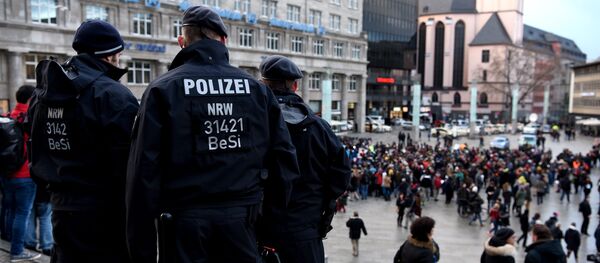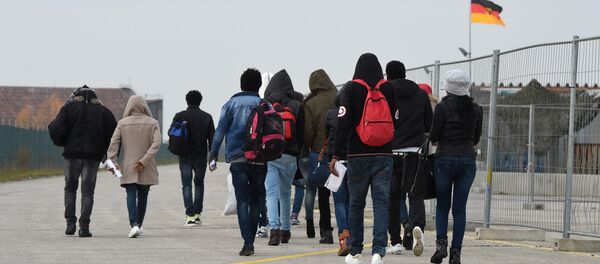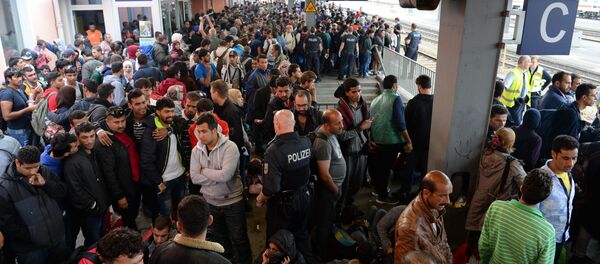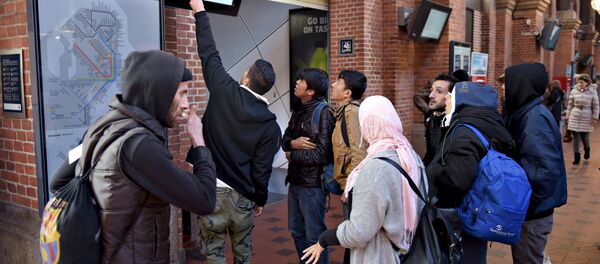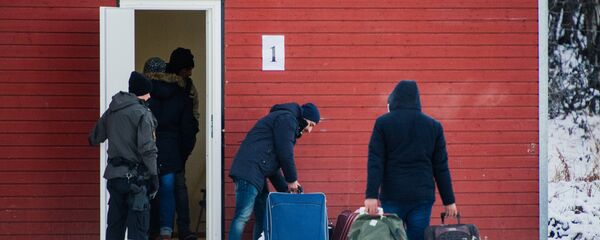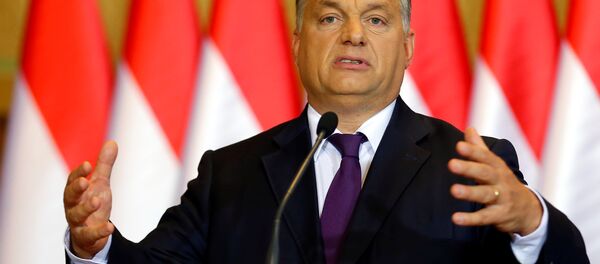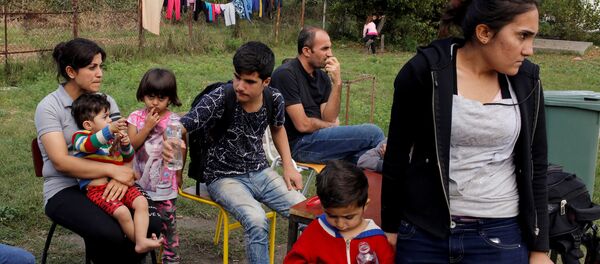MOSCOW (Sputnik) — The year of 2016 has become a turning point in the European Union's attitude toward migrants that en masse poured into the bloc the year before, fleeing from wars and poverty in the Middle-East and Africa.
After initial attempts to help people in need out of humanistic and humanitarian considerations, most EU states later moved to toughen their stance on the unexpected guests by passing harsh anti-migrant legislation to prevent further arrivals and avoid larger financial burdens.
GERMANY’S HEARTFELT WELCOME TURNS COLDER
After accepting 890,000 migrants in 2015 (the data has been revised from the previously estimated 1.1 million), this year Germany saw only 213,000 new asylum-seekers. The huge number of arrivals raised the issue of their further integration.
In July, Germany passed its first-ever integration law, which Merkel described as "an offer that carries certain duties with it." The law's stick-and-carrot approach suggested creating some 100,000 low-paid jobs, accessible to migrants during the asylum-application process, but also prescribed benefit cuts for those migrants who neglected mandatory integration courses and German language classes.
In November, Friedrich Ebert Foundation, associated with the centre-left Social Democratic Party (SDP), published a report which found 4 out of 10 Germans fear their country was being subverted to Islam. At the same time, the report said that majority – some 56 percent — were still in favor of accepting refugees, while 20 percent were unsatisfied with the fact that Germany already took in so many asylum seekers.
Terror attacks this summer in several German cities, as well as earlier women’s abuse in Cologne, committed by refugees, further fueled public discontent, with the anti-migrant far-right opposition Alternative for Germany (AfD) party capitalizing on these sentiments. The rising popularity of AfD, which now has seats in 10 out of 16 state parliaments and has a good chance of entering Bundestag next year, as well as pressure from Merkel’s traditional allies in Bavaria, forced the German chancellor to backtrack on her initial enthusiasm about the country’s ability to cope with migrants.
After rejecting Bavarian Christian Social Union leader Horst Seehofer’s idea to introduce an annual refugee cap of 200,000 in Germany, in an astonishing U-turn in late November, Merkel announced that "the most important thing in the coming months is repatriation, repatriation and once more, repatriation." The chancellor added that she was expecting 100,000 migrants to leave Germany this year, of which a third might be forcibly removed.
Next autumn, Germany will hold general elections. Merkel, who is currently in her third term, has already announced her bid to stand again. In a situation where many link Merkel’s open-door policy to the significant increase in crime rate in Germany – a 31.6-percent increase on the year before, according to November report by the German Federal Police – Merkel securing a victory without a change of heart on the migration issue seems doubtful.
AUSTRIA BUILDS OBSTACLE COURSE FOR IMMIGRANTS
Upon seeing hundreds of thousands of migrants marching through Austria and 90,000 staying to seek asylum last year — the bloc’s second highest figure per head of population – in February, the coalition government agreed with the neighboring countries on measures to close the so-called West Balkan route, used by migrants fleeing wars in Syria and elsewhere, and then announced a cap on the number of migrants the country would receive this year — 37,500 people for 2016 and 35,000 for 2017.
In early 2016, amid 25,500 asylum applications being filed by Afghan citizens, Austria announced it would launch an advertising campaign with billboards, television ads and public bus banners in Afghanistan to discourage Afghans from trying to reach Europe. Besides, over the course of the year, Austrian authorities stated many times that Vienna was planning to build a fence on its border with Italy for protection in the event of an upsurge in migrant numbers.
In mid-November, the Interior Ministry announced that 40 percent of Islamist radicals identified in Austria in the past few years had arrived as migrants looking for asylum. And even though Austria was lucky to avoid terror attacks, it still faced an overall 38.8-percent rise in the number of criminal complaints made against migrants since the beginning of 2015, as well as an evident surge in murder, rape and fraud cases committed by non-Austrians.
The most evident consequence of people's dissatisfaction with migrants and problems related to their stay in the country has been the rise of the far-right Freedom party, which skillfully played on fears about immigration, becoming Austria’s most popular political movement, now polling at more than 30 percent. The Freedom party's nominee Norbert Hofer lost in the December 4 presidential election rerun, but a narrow margin of his rival’s victory serves as another proof of Austrians' anti-migrants sentiments.
Back in March, Greek Prime Minister Alexis Tsipras criticized Austrian Chancellor Werner Faymann's decisions to close borders for migrants, saying that the move to toughen rules on refugees was being driven by the chancellor’s fear of the extreme right. According to Tsipras, Faymann was "in a political panic" ahead of the presidential election.
‘STRICT BUT FAIR’ POLICIES OF NORDIC COUNTRIES
Denmark, which received 21,000 asylum-seekers in 2015, saw the number of asylum applications drop to 5,500 in the first ten months of 2016. Norway, not a member of the European Union but part of the Schengen area, saw an even more dramatic fall in the number of arrivals: in 2015, the country received 31,000 asylum-seekers, while in 2016 this number stood just at 2,000.
Since the start of this year, both governments, which include right-wing anti-migration parties, despite being lambasted for their harsh stance on migrants by numerous human rights organizations as well as by the leftist opposition, have been conducting strict border checks and offering financial incentives for migrants to leave voluntarily. This came in addition to laws that Copenhagen and Oslo passed to toughen their asylum policies and make their countries as unattractive to migrants as possible.
Oslo even started a wide advertisement campaign in some of the less economically developed nations to convey a message that migrants not facing war or persecution would be deported from Norway.
The most effective tool to prevent new migrants from seeking asylum in Scandinavia was in fact the package of laws with new rules for migrants and asylum seekers, adopted in June in Norway, and later almost mirrored in Denmark. Both countries severely restricted family reunions, extended the qualifying period for obtaining a permanent residence permit and enabled the immigration authorities to reject applications from asylum seekers who enter Norway and Denmark through a neighboring country.
However, in mid-2016, the left-wing government dared to toughen its stance, passing the law that limited asylum seekers' possibilities of being granted residence, refused daily allowances to persons with expulsion order and those being refused asylum, and limited the possibility for an applicant's family to come to Sweden. The new law entered into force on July 20 and will be valid for three years.
In October, Stockholm also agreed a deal with the Afghan government to repatriate people who claim asylum in Sweden, provided that Kabul protects its returning citizens from harassment and persecution if Stockholm covers the transport costs of their return.
EASTERN EUROPE’S CONSISTENT ANTI-MIGRANT SENTIMENTS
In late 2015, Hungary was among the first countries to build a fence along its borders with Serbia and then Croatia in order to stem the massive tide of migrants. Other Balkan countries, including non-EU member Macedonia, that borders Greece — the main Mediterranean gateway for migrants — followed the suit.
Also late last year, Hungary and Slovakia filed separate challenges within the European Court of Justice on the EU mandatory relocation scheme of 160,000 migrants across the bloc: this scheme was adopted last September and prescribed that each EU member state must shelter its share of migrants, being relocated from Italy and Greece depending on country's size, economy and population.
Hungary is not the sole Eastern European state apparently displeased with migrants. In fact, Romania, Slovakia, Poland and the Czech Republic have also expressed opposition to accepting migrants, and never took any from Greece and Italy, or took just a few.
Lately, according to the recent reports of the Hungarian state television, the country's prisoners have been building a second-line fence to reinforce the existing barrier along the 175-kilometer-long border. According to Orban, there is a risk that the EU migrant deal with Turkey, agreed in March, would not last long, which means Europe could need to strengthen its border defenses.


